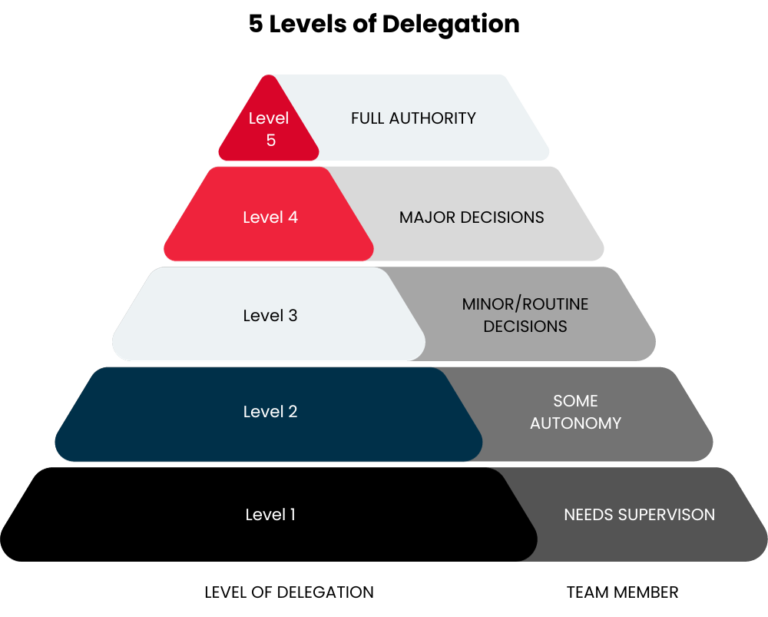Team Empowerment Guide: Mastering Trust and Your Leadership Influence
Embark on an exploration of leadership intricacies, trust dynamics, and effective decision-making, with a central focus on the pivotal role of trust in team success. Elevate your leadership by embracing authenticity, fostering initiative, and implementing the strategic 5 Levels of Delegation framework. Reflect on your delegation approach, considering team strengths and maintaining a judicious balance. Delegating decision-making not only enhances organizational efficiency but also liberates leaders for strategic endeavors. By integrating these insights, unlock your team’s potential, fostering a professional environment characterized by trust and sustained growth.
Building Trust in Leadership: The Essence of Connection
Trust forms the cornerstone of effective leadership, transcending mere formality to become the bedrock for your team’s success.
Authenticity is the Key
Genuine leadership begins with authenticity. Sharing both triumphs and challenges creates a vulnerability that fosters a profound human connection. It goes beyond the typical leader-subordinate dynamic, signaling that you’re not just a leader but a fellow journeyer. By opening up and revealing your own experiences, you pave the way for a deeper understanding and trust within the team.
Example: Illustrate this principle by recounting a pivotal moment in your career where you faced adversity. Emphasize the lessons learned and the subsequent personal and professional growth. This narrative not only showcases authenticity but also provides a tangible example of overcoming challenges.
One of the most memorable experiences I share was my first job out of university. I traveled across the U.S. and away from my family and social network. When I arrived, I was told that my position had changed and I would not be assisting, but in charge of everything. It was a trial under fire, but I gained confidence in myself that carried on past my time there.
Active Listening
Understanding your team members is essential for building trust. Genuine, active listening demonstrates that their ideas, concerns, and aspirations are valued. This approach fosters a sense of importance and encourages team members to feel heard and understood.
Example: Implement active listening during team meetings. Engage with each team member’s contributions, not just passively, but by asking thoughtful follow-up questions. This demonstrates genuine interest, reinforces the value of their input, and creates a collaborative atmosphere where everyone’s voice matters.
In essence, building trust involves more than a checklist; it requires a commitment to authenticity and active engagement. By incorporating these practices, leaders can create an environment where trust thrives, paving the way for effective collaboration and success within the team
"The art of communication is the language of leadership."
James Humes
Communicating Expectations Clearly
In the realm of effective leadership, clear communication stands as the foundational pillar. It goes beyond just expressing expectations; it’s about ensuring that your team comprehensively understands what you expect.
Define Clear Objectives
Begin by outlining the objectives of a project or task with utmost clarity. Specify the desired outcomes and set criteria for success. This precision provides the team with a roadmap, aligning their efforts harmoniously with the overall vision. An illustrative example involves explicitly stating that the goal of a marketing campaign is to increase customer engagement by 20% within the next quarter.
Set Realistic Expectations
Avoid ambiguity by establishing realistic expectations. Consider the capabilities of the team and the available resources. Realistic expectations not only foster a sense of achievement but also prevent unnecessary stress. For instance, does everything need to be done immediately? Understand that success is dependent on many factors and that progress may take time. So, acknowledge and encourage steady, sustainable growth.
Foster Open Communication Channels
Create an environment where team members feel at ease seeking clarification. Encourage questions and feedback, nurturing a culture of open communication that acts as a safeguard against misunderstandings. Holding regular team meetings, or one-on-ones provides a platform where members can openly discuss concerns or seek clarification on project expectations, fostering a collaborative and transparent working environment.
Encouraging Initiative
Initiative stands as the propelling force behind innovation and organizational growth. Fostering a culture that encourages your team members to take initiative empowers them to actively contribute to the success of the organization.
Recognize and Celebrate Initiative
Actively acknowledging and celebrating instances where team members take initiative is paramount to advancing a powerful workforce. While some may not feel comfortable with public recognition, doing so not only reinforces the value of proactivity but also serves as a motivating factor for others to follow suit. An illustrative example involves highlighting a team member who identified a process improvement and took the initiative to implement it, showcasing the positive impact of proactive contributions.
Encourage Risk-Taking
Creating a safe space for your team to take calculated risks is fundamental to fostering initiative. Encouraging team members to explore new ideas and approaches, even if it means encountering occasional setbacks, is key to promoting creativity and innovation. Applauding your team members who take calculated risks not only acknowledges their courage but also emphasizes the importance of learning from both successes and challenges in cultivating a culture that embraces innovation and forward-thinking.

5 Levels of Delegation: A Framework
The 5 Levels of Delegation stands as a strategic framework meticulously crafted to assist leaders in the efficient distribution of tasks and decision-making responsibilities. Often credited to the expertise of leadership authority John C. Maxwell, this model offers a structured approach to striking a balance between control and autonomy within a team.
Level 1: Direct Supervision
At the initial stage, leaders are advised to provide crystal-clear instructions and closely oversee tasks. This level proves most effective for new team members or when tasks demand precision. An illustrative example involves guiding a newcomer through a specific task, offering guidance and constructive feedback along the way.
Level 2: General Supervision
As trust progressively builds, team members are granted increased autonomy. While leaders still provide guidelines and expectations, flexibility in approach is encouraged. This level promotes problem-solving and creativity. An applicable scenario is assigning a project with well-defined parameters, allowing the team member to decide on the best course of action within those boundaries.
Level 3: Full Authority for Routine Decisions
At this stage, team members are entrusted with making routine decisions without seeking prior approval. This level nurtures a sense of responsibility and autonomy in managing daily tasks. An example includes delegating routine decision-making tasks, such as scheduling, budgeting, or resource allocation, to a team member, demonstrating trust in their judgment.
Level 4: Full Authority for Most Decisions
For complex projects or tasks, team members are given the authority to make most decisions independently. Leaders intervene solely for major strategic decisions or unforeseen challenges. Entrusting a team member with the planning and execution of a significant project exemplifies this level, with leader intervention limited to major milestones or strategic decisions.
Level 5: Full Authority for All Decisions
At the pinnacle of delegation, seasoned team members who have proven their capability and reliability are granted complete autonomy. This level involves delegating an entire project, from inception to completion, to a highly skilled and experienced team member. Here, they are empowered to make all decisions without constant oversight, showcasing a deep level of trust in their expertise.
By embracing the 5 Levels of Delegation, you grow and empower your team members over time. Some members may start at different levels based on their career experience, but your goal remains the same–progressing team members to full authority to help them realize their full potential.
Reflection: How do you approach delegation differently with your team members? Do you reflect on their expertise and strengths when delegating assignments? Are you actively pursuing delegating more responsibility to them for their growth and increasing trust along the way or are you taking on too much control?
Reflection: How do you approach delegation differently with your team members? Do you reflect on their expertise and strengths when delegating assignments? How are you actively pursuing delegating more responsibility to them for their growth?
Benefits of Delegating Decision-Making:
When you think about the advantages of delegating decision-making, it’s essential to consider how it impacts both you and your team.
Benefits for You, the Leader
Time Liberation
Delegating decision-making liberates you from the minutiae of day-to-day choices. Entrusting your team with decision-making responsibilities allows you to redirect your focus toward strategic initiatives and long-term vision. This time liberation empowers you to engage in higher-level thinking, contributing to the overall success of the organization.
Team Empowerment
Empowered teams are crucial for increased productivity and innovation. Delegating decision-making responsibilities fosters a positive and dynamic work culture where your team members feel valued and trusted. As your teams become more self-reliant and empowered, they actively contribute to achieving organizational goals and drive innovation, creating a thriving and collaborative work environment.
Benefits for Your Team
Professional Growth
By entrusting your team with decision-making responsibilities, you propel their professional development forward. The increased autonomy provides them with valuable learning experiences, instilling a heightened sense of ownership and pride in their work.
Increased Job Satisfaction
Granting autonomy in decision-making translates into a more fulfilling work experience for your team. This newfound independence boosts morale and overall job satisfaction among team members, creating a positive and motivating work environment.
By applying this knowledge, you unlock your team’s growth potential and catalyze the transformation of your organization. Building a trust-centered culture takes time, yet by delegating responsibilities, encouraging initiative, and communicating expectations, you not only unleash their potential but also liberate yourself for personal growth as a leader.

